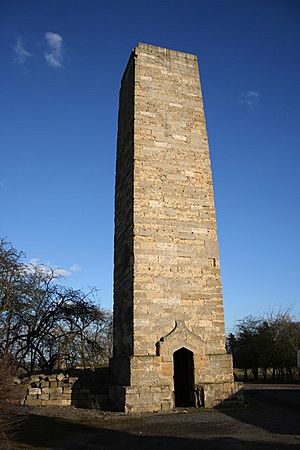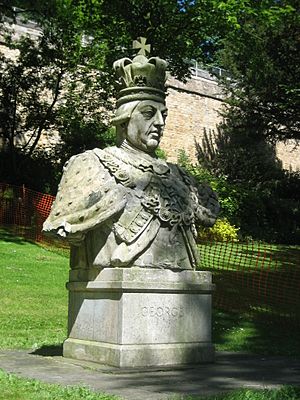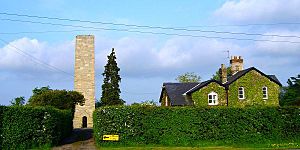Dunston Pillar facts for kids
Dunston Pillar is a famous stone tower in Lincolnshire, England. It is a "listed building," which means it's important and protected. This tall pillar once worked like a lighthouse, but for people traveling on land! It stands next to the A15 road, about 6 miles (10 km) south of Lincoln. You can find it near the village of Dunston.
Contents
What is Dunston Pillar?
Dunston Pillar is a unique landmark. It was built a long time ago, in 1751. Its main job was to help people find their way across a dark and sometimes dangerous area. Imagine trying to travel at night before streetlights existed! The pillar provided a guiding light.
Why Was it Built?
Sir Francis Dashwood had the pillar built in 1751. It was a special gift for his wife, Sarah. She was worried about crossing the dark heathland near her childhood home. This area was known for many robberies by highwaymen, who were like old-time bandits. The pillar's light made the journey safer for everyone. In 1843, a journal even called it the "only land light-house ever raised."
How the Pillar Looked
The pillar was originally 92 feet (28 meters) tall. Inside, there was a staircase. At the very top, a large, eight-sided lantern shone brightly. This light helped travelers cross the wild open land south of Lincoln. The lantern was lit regularly until 1788. It was used for the last time in 1808. By then, new roads had been built, so the light was not needed as much.
A Place for Fun
Sir Francis Dashwood also made the area around Dunston Pillar a nice place to visit. He planted trees and added a bowling green. It became a popular spot for picnics, tea parties, and games. A two-story dining hall was even built later. People called it the "Vauxhall" of Lincolnshire, like a famous pleasure garden in London. A group called the Lincoln Club was formed just to plan fun events there.
Changes Over Time
In 1808, a big storm damaged the lantern at the top of the pillar. Two years later, in 1810, the 4th Earl of Buckinghamshire replaced it. He put a statue of King George III on top instead. This was to celebrate 50 years of the king's rule. The statue was made from a special material called Coade stone.
A Shorter Pillar
Many years later, in 1940, the pillar was still very tall. It was thought to be a danger to planes flying low near RAF Coleby Grange, a nearby air force base. So, the tower was made shorter. About 40 feet (12 meters) were removed from its height to keep pilots safe. When this happened, the large statue of King George III was taken down and broken apart. You can still see a part of the statue, the bust (head and shoulders), at Lincoln Castle. This bust is also a protected historical item.
Today, Dunston Pillar is still a well-known landmark. It stands proudly beside the busy road, a reminder of its long history.





